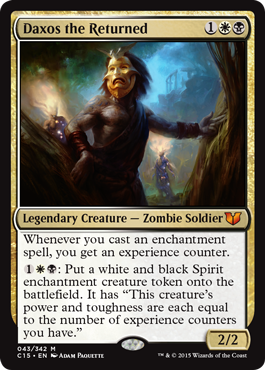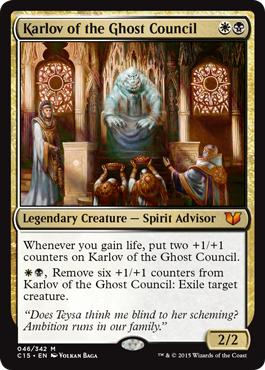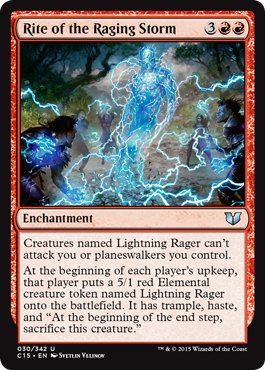Welcome back to Magic Gatherings!
We’ve spent the last few weeks talking about Standard and how the cards from Battle for Zendikar have helped shape it. But the Magic calendar waits for no column, and there’s already have a new release on the horizon: Commander 2015, the latest in Wizards’ now-annual multiplayer precon series.
I won’t cover every single new card, but you can see the full visual spoiler here and the cards in each deck here. On the latter page, new cards will show up in the “Other” column, since they’re not in Gatherer (WotC’s Magic card database) yet. Let’s get to it!
New Commanders
The best part of the Commander series is the new commanders Wizards designs, which (hopefully) enable interesting new decks designed around them. Traditionally these break down into two cycles: five marquee cards that intersect with each year’s major mechanical theme, and five alternate commanders who push the decks into slightly different thematic space.
In Commander 2013, for example, the “Mind Seize” deck (blue-black-red) was headed up by [mtg_card]Jeleva, Nephalia’s Scourge[/mtg_card], whose ability tied into the set’s rough “Command Zone matters” theme. Her backup was [mtg_card]Nekusar, the Mindrazer[/mtg_card], who suggested a “death by riches” deck that punishes opponents for drawing cards and having large hand sizes. The two overlap on some hefty card draw spells ([mtg_card]Incendiary Command[/mtg_card], for example), but you could also pull apart the precon and build distinctly different decks around each respective commander. It’s part of what makes the Commander series a good value, especially for players who are new to the format.
Commander 2015 has a pretty good slate of new team captains and alternates. The “main” commanders in each color combination all play off this year’s signature “experience” mechanic: each commander rewards a particular game action by giving experience counters to you, the player, and their power increases as you accrue more experience. It’s a nice way to evoke leveling up, while accepting the reality of Magic‘s mechanics, which normally don’t let you track a card through multiple zones. The “backup” commanders are a more diverse lot, as we’ll see.
The white-black deck is headlined by Daxos the Returned, who pays you off for casting enchantment spells: as you get more experience, the tokens he creates get bigger and bigger. This is new territory for these colors; while we’ve seen enchantment-centric commanders like [mtg_card]Bruna, Light of Alabaster[/mtg_card], [mtg_card]Zur, the Enchanter[/mtg_card], and even [mtg_card]Pharika, God of Affliction[/mtg_card], there hasn’t yet been anything in the white-black color combination. Daxos’s token-making ability is quite flexible, as well, since it gives creature tokens that also count as enchantments—they’ll be happy to trigger constellation abilities, wear equipment, get enchanted, or be sacrificed, as you happen to need them.
The backup commander here is Karlov, one of the members of the Orzhov guild’s Ghost Council, and I gotta say, wow—this is probably an even better commander for my white-black deck than Obzedat, who’s currently helming it. I originally built the deck for Two-Headed Giant commander games, where the extort mechanic gets a boost (since you have two opponents, each extort trigger drains a total of two life and gives you a total of two life). As a result, the deck is stacked with tiny lifegain triggers. You don’t gain much life each time, but Karlov cares about the number of times you tithe, not the overall value. For additional inspiration, try this article by Alex Ullman and Carlos Gutierrez.

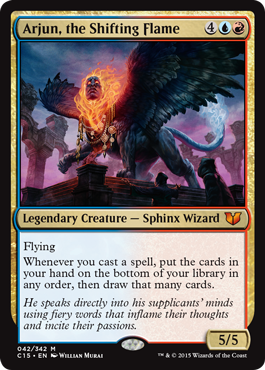 The blue-red deck is led by Mizzix of the Izmagnus, an Izzet goblin named in the grand Izzet tradition of throwing the last tiles in your Scrabble rack on the board and hoping your opponent doesn’t grab the dictionary. Mizzix wants you to cast progressively bigger instants and sorceries, and if you do, she becomes a progressively more powerful [mtg_card]Goblin Electromancer[/mtg_card]. The key is that her ability also reduces alternate and additional costs, so you also get a discount on awaken, kicker, overload, flashback, and buyback costs. Those abilities are a good fit, since Mizzix wants to head up a deck that has a lot of different mana costs (so you can climb the stairs to accrue experience), but also a lot of big mana costs, so you benefit from her cost-saving genius. If you built your deck with all enormous spells, your hand would too often be cluttered with things you couldn’t cast. Flexible mana costs or alternate casting costs let you build up experience and enjoy the payoff.
The blue-red deck is led by Mizzix of the Izmagnus, an Izzet goblin named in the grand Izzet tradition of throwing the last tiles in your Scrabble rack on the board and hoping your opponent doesn’t grab the dictionary. Mizzix wants you to cast progressively bigger instants and sorceries, and if you do, she becomes a progressively more powerful [mtg_card]Goblin Electromancer[/mtg_card]. The key is that her ability also reduces alternate and additional costs, so you also get a discount on awaken, kicker, overload, flashback, and buyback costs. Those abilities are a good fit, since Mizzix wants to head up a deck that has a lot of different mana costs (so you can climb the stairs to accrue experience), but also a lot of big mana costs, so you benefit from her cost-saving genius. If you built your deck with all enormous spells, your hand would too often be cluttered with things you couldn’t cast. Flexible mana costs or alternate casting costs let you build up experience and enjoy the payoff.
Arjun comes with a permanent [mtg_card]Mindmoil[/mtg_card], which is a card I remember drafting in original Ravnica block, though I can’t remember why I thought it would be a good idea to put it in a draft deck. It’s an intriguing effect for Commander, where it lets you plow through your deck to find a specific card or effect—a less precise kind of tutoring that seems especially well suited to a singleton format. Anything that triggers off of card draw ([mtg_card]Niv-Mizzet, the Firemind[/mtg_card], [mtg_card]Diviner’s Wand[/mtg_card], [mtg_card]Chasm Skulker[/mtg_card]) will thrive in his deck. Remember that he’s more effective the bigger your hand is, so pack plenty of additional card draw to keep your hand topped up.
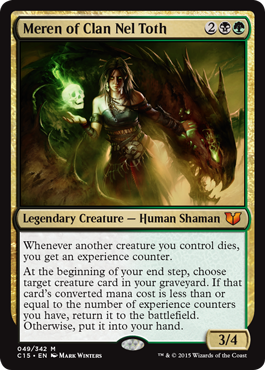
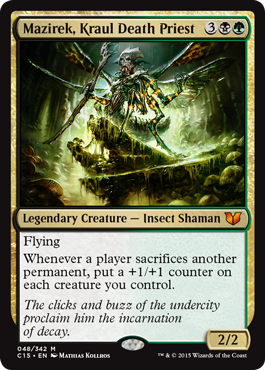 Meren of Clan Nel Toth and Mazirek lead the black-green deck. They both demand sacrifice, but they each push that theme in a slightly different direction. Meren specifically needs you to sacrifice your own creatures (really, she just wants your dudes to die, but sacrificing them is the most efficient and reliable way to accomplish that); in return, she starts bringing progressively larger creatures back from the dead. These two abilities feed each other, as each creature returned to the battlefield is another that can be sacrificed. In addition, Meren benefits from effects that stock up your graveyard. A card like [mtg_card]Satyr Wayfinder[/mtg_card] (included in the precon) is a great example of what she’s looking for: it has a good ETB trigger, it dumps new cards into your graveyard, it’s not a loss to sacrifice it, and it has a low mana cost, so you can start bringing it back right away. Note that you get to draw the card Meren targets if you don’t have enough experience to reanimate it, so you can stock up your hand for later or cast the card honestly.
Meren of Clan Nel Toth and Mazirek lead the black-green deck. They both demand sacrifice, but they each push that theme in a slightly different direction. Meren specifically needs you to sacrifice your own creatures (really, she just wants your dudes to die, but sacrificing them is the most efficient and reliable way to accomplish that); in return, she starts bringing progressively larger creatures back from the dead. These two abilities feed each other, as each creature returned to the battlefield is another that can be sacrificed. In addition, Meren benefits from effects that stock up your graveyard. A card like [mtg_card]Satyr Wayfinder[/mtg_card] (included in the precon) is a great example of what she’s looking for: it has a good ETB trigger, it dumps new cards into your graveyard, it’s not a loss to sacrifice it, and it has a low mana cost, so you can start bringing it back right away. Note that you get to draw the card Meren targets if you don’t have enough experience to reanimate it, so you can stock up your hand for later or cast the card honestly.
Mazirek triggers off any player sacrificing any kind of permanent, which makes for slightly more open deckbuilding—it doesn’t have to be creatures, and it doesn’t have to be you who sacrifices them. In particular, he makes any effect that makes every player sacrifice a permanent extremely good; be on the lookout, too, because lots of cards that see Commander play naturally sacrifice themselves—fetchlands, [mtg_card]Evolving Wilds[/mtg_card], and [mtg_card]Burnished Hart[/mtg_card] are some to watch for. Because his ability gets better when you control more creatures, tokens make for a logical fit, as you’ll have lots of fodder to sacrifice and lots of minions to buff up.
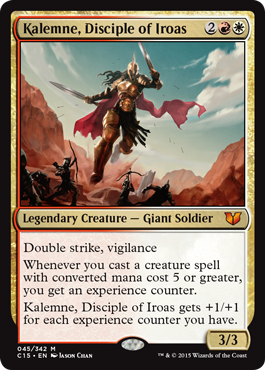
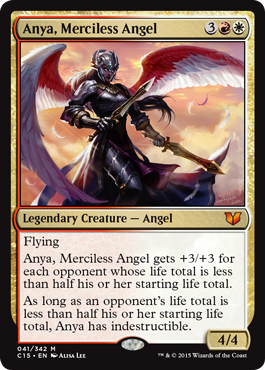 Like other red-white commanders, Kalemne and Anya push toward aggression, which is a difficult style to play in a format where you have three opponents who all start with 40 life. After last year’s mono-red Commander deck seriously expanded red’s interactions with artifacts, it’s a bit disappointing that neither of these commanders push into new mechanical territory. (See this post from the excellent Commander Theory for some suggestions.)
Like other red-white commanders, Kalemne and Anya push toward aggression, which is a difficult style to play in a format where you have three opponents who all start with 40 life. After last year’s mono-red Commander deck seriously expanded red’s interactions with artifacts, it’s a bit disappointing that neither of these commanders push into new mechanical territory. (See this post from the excellent Commander Theory for some suggestions.)
Kalemne (say it with me: “ka-LEM-nee”) asks for lots of other big creatures to lead into battle, and I do have to say that I think the Giant tribal themes in her deck seem like fun. Having lots of other big creatures can help the aggressive angle, because the third or fourth giant might kill them if the first or second doesn’t. She would particularly like creatures with flash, or haste, or juicy ETB triggers; tapping out every turn for a single large creature that doesn’t do anything right away leaves your opponents too much time to respond.
Anya seems like she is meant to close out the game quickly after your initial rush gets your opponents to low life totals, but there’s some difficult tension there: as you eliminate players, she gets weaker again. It’s an interesting conundrum, but I think her stats are a little too weak to make her a compelling option.
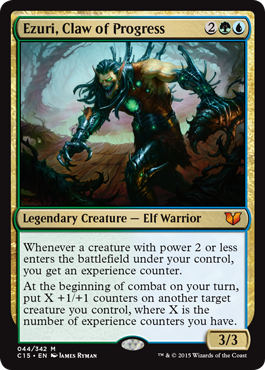
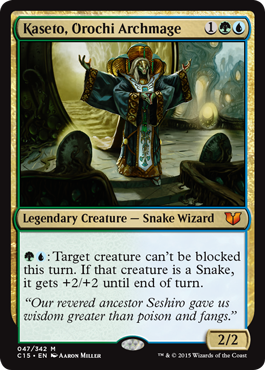 Ezuri, the Claw of Progress—formerly [mtg_card]Ezuri, Renegade Leader[/mtg_card], now doing the full Locutus as a thrall to the very Phyrexians he fought against—heads up the green-blue deck. He’s a very interesting design, in that he supports a “go wide” strategy (putting lots of small creatures onto the board), which leads into a “go tall” strategy (get one enormous creature). His experience trigger only asks that creatures enter the battlefield (not be cast, unlike Kalemne and Daxos), so he works very well with tokens. At the same time, there are all manner of shenanigans you can get up to when you can put large amounts of +1/+1 counters on a creature every turn. He strikes me as a fairer version of [mtg_card]Prossh, Skyraider of Kher[/mtg_card], in that his power increases steadily over the course of the game, to the point that it just overwhelms your opponents’ ability to answer it. At the same time, other players have a fighting chance: Prossh’s win condition is her “cast” trigger, which is essentially uncounterable.
Ezuri, the Claw of Progress—formerly [mtg_card]Ezuri, Renegade Leader[/mtg_card], now doing the full Locutus as a thrall to the very Phyrexians he fought against—heads up the green-blue deck. He’s a very interesting design, in that he supports a “go wide” strategy (putting lots of small creatures onto the board), which leads into a “go tall” strategy (get one enormous creature). His experience trigger only asks that creatures enter the battlefield (not be cast, unlike Kalemne and Daxos), so he works very well with tokens. At the same time, there are all manner of shenanigans you can get up to when you can put large amounts of +1/+1 counters on a creature every turn. He strikes me as a fairer version of [mtg_card]Prossh, Skyraider of Kher[/mtg_card], in that his power increases steadily over the course of the game, to the point that it just overwhelms your opponents’ ability to answer it. At the same time, other players have a fighting chance: Prossh’s win condition is her “cast” trigger, which is essentially uncounterable.
Kaseto hits me right in the feels because Kamigawa, home of the Orochi snakefolk, was the current block when I got back into Magic during college. He’s a good snake tribal commander, obviously, but he could be useful in any deck packing a lot of combat damage triggers—the creature doesn’t need to be a snake to be targeted.
New Cards
In addition to new commanders, each Commander series releases a slew of new cards for players to use. This year’s entry features a number of exciting and elegant designs:
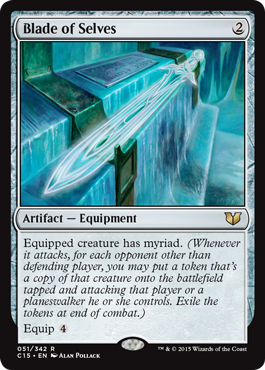 This card looks innocent enough at first, and I actually glossed over it when it got spoiled in Matt Tabak’s Commander 2015 rules column. Whoops! This card is actually busted AF, folks. It generates multiple copies of enters-the-battlefield triggers every time you attack, so any creature with an ETB trigger will give great value. This is, in fact, probably the most tame thing you can do with the card. For true craziness, you can copy creatures that pump each other, trigger on combat damage, or have have abilities that trigger “whenever” something happens—each copy sees the others enter the battlefield and deal damage, so your triggers grow geometrically. See this article by PucaTrade’s Eric Freytag for some inspiration. My favorite so far is [mtg_card]Drogskol Reaver[/mtg_card].
This card looks innocent enough at first, and I actually glossed over it when it got spoiled in Matt Tabak’s Commander 2015 rules column. Whoops! This card is actually busted AF, folks. It generates multiple copies of enters-the-battlefield triggers every time you attack, so any creature with an ETB trigger will give great value. This is, in fact, probably the most tame thing you can do with the card. For true craziness, you can copy creatures that pump each other, trigger on combat damage, or have have abilities that trigger “whenever” something happens—each copy sees the others enter the battlefield and deal damage, so your triggers grow geometrically. See this article by PucaTrade’s Eric Freytag for some inspiration. My favorite so far is [mtg_card]Drogskol Reaver[/mtg_card].
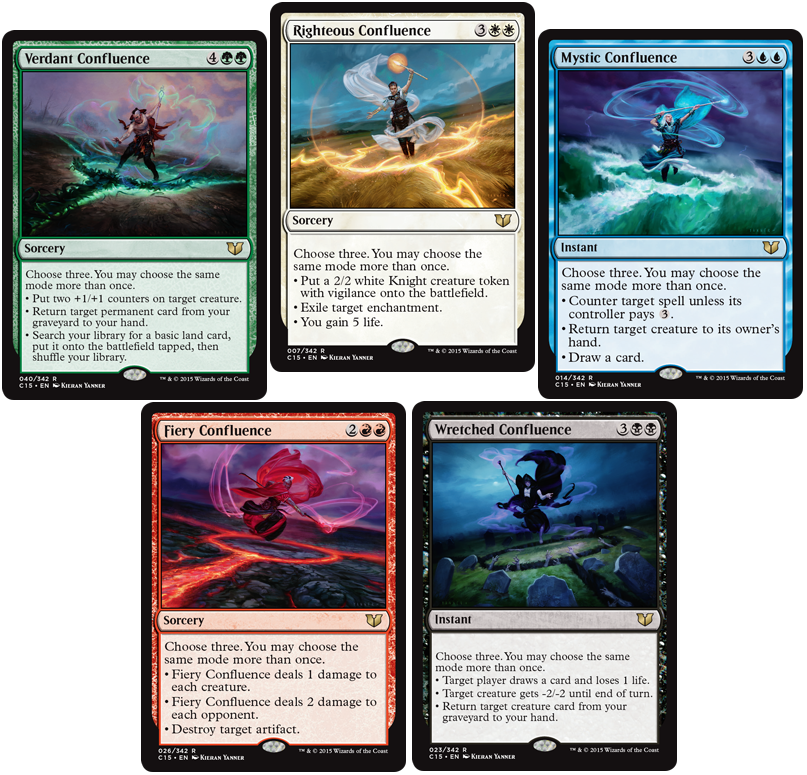 This cycle is pretty exciting, as it opens up new design space for modal cards—choosing the same option more than once. As we’ve seen from charms and commands in the past, the effects look small at first glance, but it’s easy to underestimate how powerful flexibility can be; these spells let you cobble together an effective response to a wide range of board states. [mtg_card]Mystic Confluence[/mtg_card] is particularly powerful—almost [mtg_card]Cryptic Command[/mtg_card], which is nice, since Modern demand has made that card prohibitively expensive. One rules note: if you choose the same mode twice, the Confluence will do it twice in sequence, so effects that trigger “whenever you gain life” or “whenever you draw a card” will trigger multiple times.
This cycle is pretty exciting, as it opens up new design space for modal cards—choosing the same option more than once. As we’ve seen from charms and commands in the past, the effects look small at first glance, but it’s easy to underestimate how powerful flexibility can be; these spells let you cobble together an effective response to a wide range of board states. [mtg_card]Mystic Confluence[/mtg_card] is particularly powerful—almost [mtg_card]Cryptic Command[/mtg_card], which is nice, since Modern demand has made that card prohibitively expensive. One rules note: if you choose the same mode twice, the Confluence will do it twice in sequence, so effects that trigger “whenever you gain life” or “whenever you draw a card” will trigger multiple times.
 Thief of Blood hearkens back to [mtg_card]Spike Cannibal[/mtg_card] and [mtg_card]Aether Snap[/mtg_card]. Those are good cards—longtime favorites of Commander rules committee member Sheldon Menery—but they look less powerful at first glance than they actually are. Thief of Blood combines the hit-everything potential of Aether Snap with the large body of Spike Cannibal, which hopefully makes for a sufficiently attractive package that it will see some play.
Thief of Blood hearkens back to [mtg_card]Spike Cannibal[/mtg_card] and [mtg_card]Aether Snap[/mtg_card]. Those are good cards—longtime favorites of Commander rules committee member Sheldon Menery—but they look less powerful at first glance than they actually are. Thief of Blood combines the hit-everything potential of Aether Snap with the large body of Spike Cannibal, which hopefully makes for a sufficiently attractive package that it will see some play.
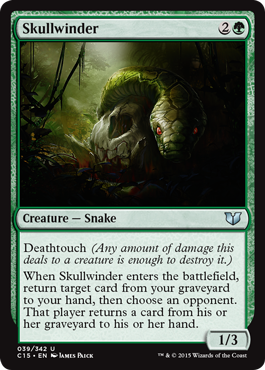 I’m always impressed when a simple-looking card can pack in tons of interesting gameplay. The symmetrical [mtg_card]Regrowth[/mtg_card] on this crafty little snake lets you play politics—you can do a favor for another player, who then (hopefully) will return in kind down the road. Maybe they get a sweet creature back? Since Skullwinder is a blocker with deathtouch, your opponent has incentive to point it in another direction. If a different opponent is threatening the whole table, maybe you and your new buddy each get back removal spells, to take him or her down a peg. Plus, you’re always free to choose an opponent with no graveyard, which will be pretty feasible in the early turns (when Skullwinder can give you back a ramp spell or a used fetchland).
I’m always impressed when a simple-looking card can pack in tons of interesting gameplay. The symmetrical [mtg_card]Regrowth[/mtg_card] on this crafty little snake lets you play politics—you can do a favor for another player, who then (hopefully) will return in kind down the road. Maybe they get a sweet creature back? Since Skullwinder is a blocker with deathtouch, your opponent has incentive to point it in another direction. If a different opponent is threatening the whole table, maybe you and your new buddy each get back removal spells, to take him or her down a peg. Plus, you’re always free to choose an opponent with no graveyard, which will be pretty feasible in the early turns (when Skullwinder can give you back a ramp spell or a used fetchland).

 Commander 2015 actually has a few other cards like this, that extend known mechanics to include additional players or all players. These sorts of cards are easy to miss, because it seems like you already understand what the card does, but the nature of multiplayer Magic naturally lends these cards a lot of complexity. “Mass [mtg_card]Banishing Light[/mtg_card]” might make you shrug when you read it, but in actual games it will generate interesting tensions. What do you exile, so that your opponents don’t gang up on you? Or, can you pick something so threatening that the other players will help you stay alive, so that that guy doesn’t get his game-breaking creature back? With [mtg_card]Dawnbreak Reclaimer[/mtg_card], do you give your opponent a good creature, in the hopes they return the favor? Do you keep targeting the same player with it, or spread the love around the table? Every game will bring a different set of variables to weigh. (No pun intended.)
Commander 2015 actually has a few other cards like this, that extend known mechanics to include additional players or all players. These sorts of cards are easy to miss, because it seems like you already understand what the card does, but the nature of multiplayer Magic naturally lends these cards a lot of complexity. “Mass [mtg_card]Banishing Light[/mtg_card]” might make you shrug when you read it, but in actual games it will generate interesting tensions. What do you exile, so that your opponents don’t gang up on you? Or, can you pick something so threatening that the other players will help you stay alive, so that that guy doesn’t get his game-breaking creature back? With [mtg_card]Dawnbreak Reclaimer[/mtg_card], do you give your opponent a good creature, in the hopes they return the favor? Do you keep targeting the same player with it, or spread the love around the table? Every game will bring a different set of variables to weigh. (No pun intended.)
 Shielded by Faith is another example, as it lacks the crucial clause “you control” when it mentions creatures entering the battlefield. A mobile [mtg_card]Indestructibility[/mtg_card] would already be pretty cool, but this is one you can attach to any creature, including your opponents’. Make a friend, keep a critical creature in play, or just toss the aura there for safekeeping. Simple card, lots of interesting choices.
Shielded by Faith is another example, as it lacks the crucial clause “you control” when it mentions creatures entering the battlefield. A mobile [mtg_card]Indestructibility[/mtg_card] would already be pretty cool, but this is one you can attach to any creature, including your opponents’. Make a friend, keep a critical creature in play, or just toss the aura there for safekeeping. Simple card, lots of interesting choices.
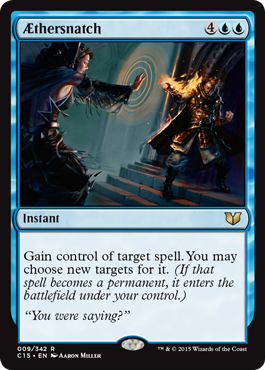 Ditto for Aethersnatch: it’s an effect we’ve seen before on Spelljack, cleaned up and made more accessible with modern templating. You can steal a cool creature, artifact, or enchantment, use it as a [mtg_card]Deflection[/mtg_card] on a removal spell, or take control of something game-altering like [mtg_card]Blatant Thievery[/mtg_card] or [mtg_card]Insurrection[/mtg_card].
Ditto for Aethersnatch: it’s an effect we’ve seen before on Spelljack, cleaned up and made more accessible with modern templating. You can steal a cool creature, artifact, or enchantment, use it as a [mtg_card]Deflection[/mtg_card] on a removal spell, or take control of something game-altering like [mtg_card]Blatant Thievery[/mtg_card] or [mtg_card]Insurrection[/mtg_card].
 Another in the “lacks a crucial bit of text you expected” series, the activated ability on Gigantoplasm doesn’t end at the end of the turn. Variable stats on clones don’t always matter, since often you want an ETB trigger or a static effect, but there are some exceptions ([mtg_card]Living Inferno[/mtg_card]), and it’s nice to have the option to make an arbitrarily large creature when you have mana lying around. Get ’em, Fblthp!
Another in the “lacks a crucial bit of text you expected” series, the activated ability on Gigantoplasm doesn’t end at the end of the turn. Variable stats on clones don’t always matter, since often you want an ETB trigger or a static effect, but there are some exceptions ([mtg_card]Living Inferno[/mtg_card]), and it’s nice to have the option to make an arbitrarily large creature when you have mana lying around. Get ’em, Fblthp!
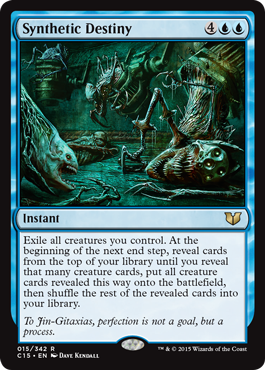 Sometimes those small tweaks in wording make a big difference. This card is almost exactly the same as [mtg_card]Mass Polymorph[/mtg_card], but the quirky timing rules allow you to use Synthetic Destiny to dodge [mtg_card]Wrath of God[/mtg_card] and other sweepers—cast this in response, and at end of turn, get your creatures back. (You can even cast it at the end of an opponent’s turn, sweep on your turn, and get creatures at the end of your turn.) It’s a nice flavor win, too, as that jaunt into exile represents their time spent in those incubation tubes. At the end of the turn, when they’re compleat, they pop back out—like birthday presents, except full of horrifying monsters.
Sometimes those small tweaks in wording make a big difference. This card is almost exactly the same as [mtg_card]Mass Polymorph[/mtg_card], but the quirky timing rules allow you to use Synthetic Destiny to dodge [mtg_card]Wrath of God[/mtg_card] and other sweepers—cast this in response, and at end of turn, get your creatures back. (You can even cast it at the end of an opponent’s turn, sweep on your turn, and get creatures at the end of your turn.) It’s a nice flavor win, too, as that jaunt into exile represents their time spent in those incubation tubes. At the end of the turn, when they’re compleat, they pop back out—like birthday presents, except full of horrifying monsters.

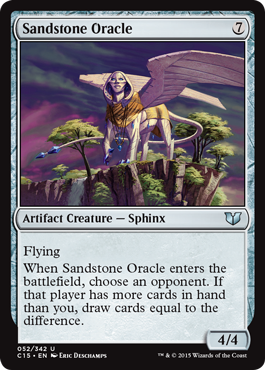 Simple effects don’t have to be bad effects, and these two cards provide nice, clean utility effects to any deck that wants to play them. Sandstone Oracle lets you play catch-up pretty nicely in the middle to later stages of the game and serves as a creature that’s solid, if unexciting. Thought Vessel is especially impressive—very elegant design, very little clutter, and very valuable to almost any deck. Commander decks like mana rocks, and having more ways to eliminate the hand size cap is always nice.
Simple effects don’t have to be bad effects, and these two cards provide nice, clean utility effects to any deck that wants to play them. Sandstone Oracle lets you play catch-up pretty nicely in the middle to later stages of the game and serves as a creature that’s solid, if unexciting. Thought Vessel is especially impressive—very elegant design, very little clutter, and very valuable to almost any deck. Commander decks like mana rocks, and having more ways to eliminate the hand size cap is always nice.
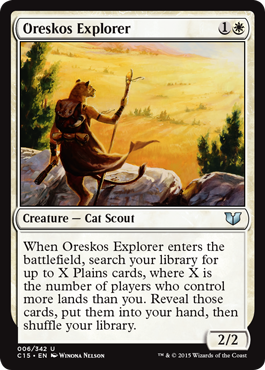 Maybe I have a thing for inexpensive mana-fixing cards? I really love this design. It’s no [mtg_card]Mulldrifter[/mtg_card], but this is card draw of a modest sort, which feels very fair—very white—and gives you a chance to catch up if your opponents are ramping up their mana, even if you have to play your land at a normal pace. I once won a very long game with my [mtg_card]Nahiri, the Lithomancer[/mtg_card] commander deck, in large part because my [mtg_card]Journeyer’s Kite[/mtg_card] made sure I never missed a land drop. The Explorer is only a few lands each trigger, but you can blink, bounce, or reanimate him, and in the late game he picks up an equipment like any other creature. Note also that “Plains cards” doesn’t mandate basic Plains, so you’re free to search up [mtg_card]Prairie Stream[/mtg_card], [mtg_card]Sacred Foundry[/mtg_card], or (if you’re so lucky) [mtg_card]Scrubland[/mtg_card], depending on what you need.
Maybe I have a thing for inexpensive mana-fixing cards? I really love this design. It’s no [mtg_card]Mulldrifter[/mtg_card], but this is card draw of a modest sort, which feels very fair—very white—and gives you a chance to catch up if your opponents are ramping up their mana, even if you have to play your land at a normal pace. I once won a very long game with my [mtg_card]Nahiri, the Lithomancer[/mtg_card] commander deck, in large part because my [mtg_card]Journeyer’s Kite[/mtg_card] made sure I never missed a land drop. The Explorer is only a few lands each trigger, but you can blink, bounce, or reanimate him, and in the late game he picks up an equipment like any other creature. Note also that “Plains cards” doesn’t mandate basic Plains, so you’re free to search up [mtg_card]Prairie Stream[/mtg_card], [mtg_card]Sacred Foundry[/mtg_card], or (if you’re so lucky) [mtg_card]Scrubland[/mtg_card], depending on what you need.
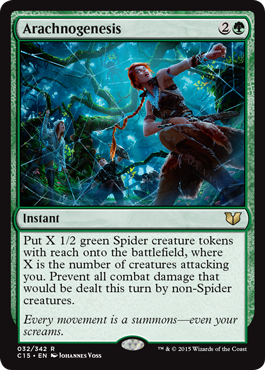 Send your opponents’s creatures to the Spider Zone! Getting even three creatures off this will probably let you pick off a random attacker, and at the worst case you [mtg_card]Fog[/mtg_card] for a turn and get some tokens to sacrifice later. You’re free to cast the spell to save someone else (by preventing combat damage), but you won’t get spiders if nothing is attacking you, so bear that in mind.
Send your opponents’s creatures to the Spider Zone! Getting even three creatures off this will probably let you pick off a random attacker, and at the worst case you [mtg_card]Fog[/mtg_card] for a turn and get some tokens to sacrifice later. You’re free to cast the spell to save someone else (by preventing combat damage), but you won’t get spiders if nothing is attacking you, so bear that in mind.
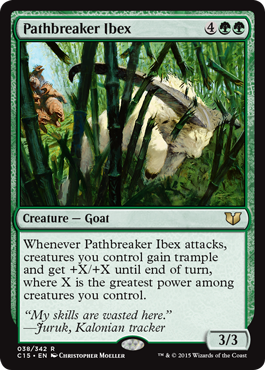 Time for some Follow the Leader? This card plays a similar game to the new Ezuri commander, in that it encourages you to have lots of creatures in play, and also have one especially large creature in play. (It’s a little strange to me that this card is in the green-black deck, rather than the green-blue deck.) The worst-case scenario here is a recurring [mtg_card]Overrun[/mtg_card], but it shouldn’t be tough for a green deck to get a 5/5 or bigger into play—[mtg_card]Avenger of Zendikar[/mtg_card], say, or any other large creature that brings its own army along.
Time for some Follow the Leader? This card plays a similar game to the new Ezuri commander, in that it encourages you to have lots of creatures in play, and also have one especially large creature in play. (It’s a little strange to me that this card is in the green-black deck, rather than the green-blue deck.) The worst-case scenario here is a recurring [mtg_card]Overrun[/mtg_card], but it shouldn’t be tough for a green deck to get a 5/5 or bigger into play—[mtg_card]Avenger of Zendikar[/mtg_card], say, or any other large creature that brings its own army along.
 [mtg_card]Wheel of Fortune[/mtg_card] is already an effect that’s easy to break, since you can activate it when you have few or no cards in hand to effectively draw more than your opponents, to say nothing of having [mtg_card]Alhammaret’s Archive[/mtg_card] or [mtg_card]Thought Reflection[/mtg_card] in play. Anything that triggers off drawing cards gets turbocharged, as well. Putting Wheel on a creature means that you can potentially repeat the effect, if you can find ways to bring the Magus back. The Magus cycles were among my favorite cards from Time Spiral block, so I’m sad this is a one-off—hopefully we’ll see this guy’s brothers and sisters in subsequent products.
[mtg_card]Wheel of Fortune[/mtg_card] is already an effect that’s easy to break, since you can activate it when you have few or no cards in hand to effectively draw more than your opponents, to say nothing of having [mtg_card]Alhammaret’s Archive[/mtg_card] or [mtg_card]Thought Reflection[/mtg_card] in play. Anything that triggers off drawing cards gets turbocharged, as well. Putting Wheel on a creature means that you can potentially repeat the effect, if you can find ways to bring the Magus back. The Magus cycles were among my favorite cards from Time Spiral block, so I’m sad this is a one-off—hopefully we’ll see this guy’s brothers and sisters in subsequent products.
I’m also a big fan of cards that push the game toward a conclusion, a theme lead designer Dan Emmons played up with the new commanders’ experience counter mechanic. The 5/1 elemental is great for attacking (attacking people who aren’t you, that is), which naturally move things forward as players take incidental damage. It’s space that Commander 2014 played around in with [mtg_card]Assault Suit[/mtg_card], in a package that’s a bit easier to understand.
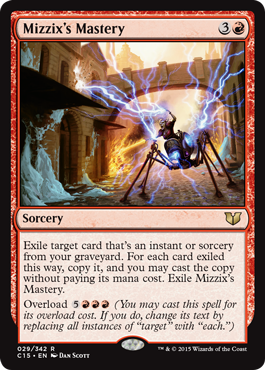 This card should also end the game pretty quickly, albeit in much more spectacular fashion. As an opponent, cards like this can be frustrating, but at least this one is more interesting than [mtg_card]Insurrection[/mtg_card]. Be happy for the cool thing your opponent does, and they’ll be happy for you when your deck does something epic next game. It’s the best way to play Commander.
This card should also end the game pretty quickly, albeit in much more spectacular fashion. As an opponent, cards like this can be frustrating, but at least this one is more interesting than [mtg_card]Insurrection[/mtg_card]. Be happy for the cool thing your opponent does, and they’ll be happy for you when your deck does something epic next game. It’s the best way to play Commander.
Overall Impressions
I like these Commander decks quite a lot. They’re full of cards that read simply, but seem like they’ll have tons of great gameplay value. More importantly, that gameplay value is rooted in their use in a multiplayer formats—they’re designed to be played in games with several opponents, and the interesting scenarios they present emerge in those contexts.
That seems like it should be obvious, but previous editions of Commander have sometimes missed that mark. In prior years, the Commander series has debuted cards like [mtg_card]True-Name Nemesis[/mtg_card] and [mtg_card]Containment Priest[/mtg_card]—cards that happen to have applications in multiplayer, but that also are just plain efficient creatures with powerful new abilities. Since cards printed in Commander decks are playable in Legacy formats (and also show up in spikier casual formats like Cube), players from those formats snapped up the precons, leading to shortages and decks being sold for well over MSRP. That’s bad for an introductory product aimed at casual players.
Instead, the new cards from Commander 2015 create opportunities for players to make decisions and interact with each other. Even better, those interactions will be different every time, because each Commander game puts different sets of cards into play. The new designs take advantage of what multiplayer formats can do that duel formats can’t, and subtly play up what’s fun about those games.
I didn’t mention reprints, but I think they did a great job there, too. These decks don’t feature expensive reprints like Wurmcoil Engine, which sees play in Modern; the priciest reprints in Commander 2015 (Gisela, [mtg_card]Black Market[/mtg_card], [mtg_card]Eldrazi Monument[/mtg_card], [mtg_card]Urza’s Incubator[/mtg_card]) come in around $10. They’re good in Commander, but they’re also only good in Commander, which should limit the impact of speculation.
On the whole, Commander 2015 provides exactly what it should: powerful new commanders, interesting multiplayer cards, and decks that should be fun out of the box, with room to be customized. That’s a win in my book.
I think I’m going to pick up the white-black deck—I don’t think I can pass up Karlov—but I’m tempted by the black-green and green-blue decks too. Which one’s your favorite? Let me know in the comments or catch me on Twitter (@cutefuzzy_).

